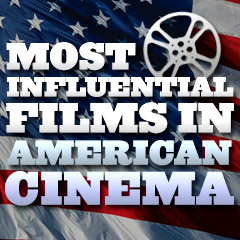Most Influential, Significant
and Important Films in American Cinema
(chronological by time period and film title)
|
|
Title Screen
|
Film Title/Year/Director/Length/Studio,
Descriptions of Influence/Significance |
Poster
|

|
Terminator 2: Judgment Day (1991)
d. James Cameron, 137/152 minutes, Carolco Pictures/TriStar Pictures/Pacific
Western
- This film was the well-executed, action-packed sequel
to the earlier film of the same name, with a great variety of action
set-pieces, chases and quotable one-liners ("Hasta la vista,
baby!")
- it still remains one of the best action films of all time, and
is one of the most influential sequels in Hollywood blockbuster
history.
- Arnold
Schwarzenegger cemented his T-800 as one of cinema's most iconic
characters. The sequel was made possible by Cameron's hugely successful
blockbuster Aliens
(1986) and The Abyss (1989). Unlike The Abyss, Terminator
2: Judgment Day would gross about a third of its budget
in its opening summer weekend (almost $32 million), despite a
running time of over two and a half hours, and end up making
back twice its budget in the United States alone.
- The science-fiction blockbuster was known for its
computer-generated special effects (created by George Lucas' Industrial
Light and Magic) and dazzling, non-stop action sequences. In the
first film, the Terminator was stop-motion animated as an armature
model unlike the second Terminator that was a product of state
of the art CGI (computer-generated imagery).
- It was also the first film in history to cost $100
million to produce - the most expensive film of its time. The exorbitant
cost was mostly due to its advanced visual effects. The film's
trailer alone cost $150,000. Arnold
Schwarzenegger's salary was reported to be between $12 and $15
million. It was Arnold's highest-grossing film of his career. Evidentally,
it paid off, as the film was the top-grossing (domestic) film of
1991, at $204.8 million, and it made $520 million (worldwide).
The film acquired four technical Academy Awards (Best Makeup, Best
Sound, Best Visual Effects, and Best Sound Effects Editing) from
its six nominations.
- The first truly believable, naturally-moving computer-generated
character (CGI) was the morphing, liquid molten metal, T-1000 cyborg
villain (Robert Patrick) in the film. It was the first groundbreaking
instance of a computer generated main character. Over 300 special
effects shots made up 16 minutes of the film's running time, although
the most complex CGI shots composed about 3 and a half
minutes of running time. A
new age would be dawning of big-budget, CGI-rich movies
such as Jurassic
Park (1993) and The Matrix
(1999).
- The film signified a huge turning point in Hollywood's
strategy on franchises and sequels. The original gritty, independent,
R-rated action flick was turned into a special-effects showcase
- that would appeal to larger and younger audiences. It also made
many times more than the 1984 film (which only made $38.4 million
domestic) - proving that sequels were big business. It also launched
the mega-career of director Cameron, who would go on to greater
heights with Titanic (1997) and Avatar (2009).
- The chief selling point,
aside from the computer-generated special effects and dazzling,
non-stop action sequences, were the two major stars, Schwarzenegger
and Linda Hamilton, who starred in the original - a major female heroine
lead. It would be followed by a mildly successful
sequel, Terminator 3: Rise of the Machines (2003), in which
only Schwarzenegger returned and faced off against a female "Terminatrix."
|

|
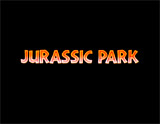
|
Jurassic Park (1993)
d. Steven Spielberg, 127 minutes, Universal Pictures/Amblin Entertainment
- This Steven Spielberg and Universal f/x laden
film (based upon Michael Crichton's 1990 novel), one of the greatest
adventure films ever made, was the Academy Award winner for Best
Achievement in Visual Effects (defeating The
Nightmare Before Christmas (1993) and Cliffhanger (1993)).
It was perhaps the most influential of all movies supplemented by CGI,
and the biggest 'monster movie' of all time. It
was the first major instance of extensively having computer-generated
animated characters mixed with live action and animatronics.
- It became the top-grossing
(domestic) film of the year, at $357 million, from an initial
production budget of $63 million. It easily surpassed the # 2 film, Mrs.
Doubtfire (1993) at $219 million, and # 3 film The Fugitive
(1993) at $184 million. This was the third time that one
of Spielberg's films became the highest grossing film ever (earlier,
he succeeded with Jaws (1975)
and E.T.:
The Extra-Terrestrial (1982)).
- DTS Digital Sound
also made its theatrical debut in the film, created to help enhance
the film's sound design. It won all three of its Academy Awards
nominations: Best Visual Effects, Best Sound, and Best Sound Editing.
- It mixed animatronic and computer-generated (CGI),
photo-realistic dinosaurs - the first of their kind, displayed
with textured skin and muscles. The ground-breaking
mix of animatronics and CGI brought the dinosaurs alive, especially
the first stunning view of a tall-necked brachiosaurus on
its hind legs eating from a tree.
- The scenes of the living, eating, and breathing
dinosaurs (including the scene of the stampeding herd of Gallimimus)
used mechanical animatronic robots and miniature models in stop-motion,
frame-by-frame processing. The T. Rex was shot using 20- and 40-
foot tall animatronics. The 20 foot-tall model weighed over 13,000
pounds.
- The CGI creatures were artificially-generated at
Industrial Light & Magic (ILM)
and very realistically-rendered and seamlessly integrated within
live-action sequences using animatronics. There were about 15 minutes
of dinosaur footage in the movie, with only 4-6 minutes generated
by computers, the rest by animatronics. The original plan to use
stop-motion versions of dinosaurs was quickly scrapped when CGI
became the better option.
- The scene of the night-time attack of the T. Rex
on a lawyer cowering in a toilet used live action and digitization
- it was the first example of a computer-generated human stunt
double, involving hyper-realistic rendering.
- As a result of the
film's success, there was a massive surge in the use of
CGI in Hollywood blockbusters. Two years later, the first feature-length
film with a digitally-created, CGI character in a leading
role occurred in Casper (1995), there were CGI stampeding
animals in Jumanji (1995),
and Toy Story (1995) was released as the first feature-length
computer-animated movie. The technological leaps in CGI only
accelerated from there and became more pervasive.
- Spielberg's vision created the indisputable standard
for all subsequent dinosaur films and television shows (i.e., the
TV-documentary series Walking With Dinosaurs (1999-2000),
the TV show Terra Nova (2011), etc.), and the film increased
interest in the study of paleontology.
- The film generated billions from its massive marketing
campaign (budgeted at about $65 million, larger than the production
budget for the film itself) and the sale of merchandise (T-shirts,
stuffed dinosaurs, action figures, fast food franchise deals, video
games, comic books, etc.) by licensing deals with over 100 companies
to market thousands of products.
- As a result of the film's success, James Cameron
founded Digital Domain (a pioneering new F/X company), with special
effects guru Stan Winston and IBM.
|

|

|
Philadelphia (1993)
d. Jonathan Demme, 125 minutes, TriStar Pictures
- The ground-breaking, historically-significant, and realistic
film Philadelphia
(1993) from Jonathan Demme was one of
the first major (mainstream) studio (big-budget) film to confront
the HIV/AIDS issue from a societal, medical, and political point
of view.
- The landmark film addressed the issues of homosexuality
and homophobia (and cases of unfounded fear) in a case of wrongful
termination. It came after the HBO-TV docu-drama And
the Band Played On (1993) about the growing AIDS crisis.
- It starred straight actors Tom Hanks
(who won his first Best Actor Oscar) and Antonio Banderas as
gay lovers. Hanks' character Andrew Beckett
was an HIV/AIDS-afflicted lawyer who contracted the disease and
was forced to sue his law firm over job discrimination - he was
ably defended by a black personal injury lawyer
Joe Miller (Denzel Washington). The presence of two major, well-respected
American actors helped to broaden awareness about the problematic disease
and related medical, political and social issues.
- The humanizing film was inspired (in part) by the
true story of attorney Geoffrey Bowers, who successfully sued the
law firm that fired him in one of the first AIDS discrimination cases
of wrongful dismissal. The drama made effective use of Bruce Springsteen's
tear-jerking Oscar-winning song Streets
of Philadelphia.
- Although well-intentioned and compelling, and its stimulation
of more empathy toward the major health issue and its societal stigma,
it was criticized by gay groups for downplaying the affectionate
romance between Hanks and Banderas, and for its many compromises
for mainstream audiences.
- It was the film that bridged actor Tom Hanks' earlier
career (of lighter comedies) to more sober and serious roles (Apollo
13 (1995), Saving Private Ryan (1998) and The Green Mile (1999)).
- During
Hanks' Oscar acceptance speech, he paid homage to his high school
gay teacher Rawley Farnsworth - the situation was later used as the
basis for the comedy In & Out
(1997) in
which a passionate Oscar winner during his acceptance speech inadvertently
outed a teacher.
|

|
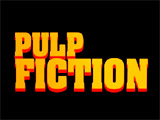
|
Pulp Fiction (1994)
d. Quentin Tarantino, 154/168 minutes, Miramax/A Band Apart/Jersey Films
- The self-indulgent, episodic low-budget film about
corruption and temptation, a modern B-movie cult classic, with
production costs of $8 million, became an immensely popular, major
independent hit for its distributor Miramax, earning $108 million
(domestic), and $214 million (worldwide). It was the 10th highest-grossing
(domestic) film of its year, when it was competing against Forrest
Gump (1994), The Lion King (1994), True Lies (1994),
and Speed
(1994).
- When the influential neo-noirish crime film opened
in May of 1994 at the Cannes Film Festival, it won the "Best
Picture" or
prestigious Palme d'Or, snatching the top award from Krzysztof Kieslowski's
trilogy swansong Three Colors: Red (1994). It was also honored
with seven Academy Award nominations, including Best Picture, Best
Director, Best Actor (John Travolta), Best Film Editing, Best Supporting
Actor (Samuel L. Jackson), Best Supporting Actress (Uma Thurman),
and won one Oscar - Best Original Screenplay (Roger Avary and Quentin
Tarantino).
- This non-formulaic, stylish, defining film of the
1990s was known for its violence, ensemble cast, pop cultural references,
rich and witty dialogue, blood-letting, vulgarities, 'sick' and
dark humor, an AM radio pop music soundtrack, and startling action.
The unpredictably shuffled, post-modern film shocked with its hip
combination of violence, sex, drugs, and profanity (including 269
F-words), and a body count of 8 dead.
- Director Quentin Tarantino, a B-movie fanatic and
ex-video store clerk, was brought to mainstream attention with
this stylish and inventive episodic thriller about corruption and
temptation. His work featured guns, femmes fatales, deadly hit-men,
and drugs. Tarantino provided rampant references to hard-boiled
fiction, to TV shows, Hong Kong action films, and to other noirish
films from The
Killers (1946) to Kiss Me Deadly (1955) and Psycho
(1960) - and
many others.
- The pop-oriented film has become legendary, with
a number of very quotable lines, a fragmented story, a great soundtrack,
the mystery of the contents of a glowing suitcase (a prominent
MacGuffin, and originally filled with diamonds in the script) with
the devil's '666' as its combination, a philosophical discussion
on French names for American fast food, and many flashbacks, flash-forwards,
plot twists and unexpected turns. Four different short-story
tales were interwoven together to tell a non-linear, non-chronological,
and intricate story of nihilistic criminal activity in LA's sleazy
underworld. The skewed script structure was revolutionary in the
way the vignettes were told.
- In the mid-1990s, it was criticized by some detractors,
and offered up as an example of the perverse and immoral direction
that the Hollywood film industry was taking - with displays of
casual violence and sex, "nightmares
of depravity," and
for promoting "the
romance of heroin."
- The highly influential independent film helped
open the doors for film school graduates and other indie films
(from the likes of Bryan Singer with The Usual Suspects (1995),
UK director Danny Boyle, and Paul Thomas Anderson with Boogie
Nights (1997)),
and changed the direction of contemporary cinema.
|

|

|
Cutthroat Island (1995)
d. Renny Harlin, 124 minutes, Carolco Pictures/MGM
- Director Renny Harlin's (known for Die
Hard 2 (1990) and Cliffhanger
(1993)) and MGM/Carolco's bloated action-comedy pirate film (before
the hugely popular Disney pirate film Pirates
of the Caribbean: The Curse of the Black Pearl (2003) with
Johnny Depp 8 years later) was one of the biggest flops of the decade
(with an eventual cost of between $98 and $115 million and box-office
of only $10 million domestic).
- It continues to enjoy the reputation of being one
of the biggest box-office bombs of all time. Its losses were phenomenal
- costs were nearly equaled by its net losses of almost $89 million
(inflation adjusted at $137 million). It was nominated for one
Razzie award: Worst Director.
- It was influential, but in
a negative way. The
independent production company Carolco (makers of the Rambo series, Total
Recall (1990), and Terminator
2: Judgment Day (1991)), didn't survive this film's failure
(and the additional failure of Showgirls (1995)), and was forced
to file for bankruptcy even before it opened, and sold most of its
assets for $50 million to 20th Century Fox.
- The swashbuckling pirate-themed movie was an adventure
tale with horrible acting, a deficient and often incoherent script,
continuity problems, spectacular but boring special effects and
action-film sequences, and logistical issues due to being filmed
on two continents (in Malta - serving both as 1600s Jamaica and
Thailand). There were six writers credited for the dubious film's
story and script, indicative of its major problems.
- Geena Davis (the director's real-life wife)
who was cast in the unlikely main role of Captain Morgan Adams,
played the modern 'feminist' role of a swashbuckling pirate queen,
but it appeared that it was too early for female action heroes of
her ilk, and her future bankability suffered.
|

|
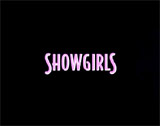
|
Showgirls (1995)
d. Paul Verhoeven, 131/128 minutes, Carolco Pictures/United Artists/Chargeurs/Vegas
Productions
- Director Paul Verhoeven's and screenwriter Joe Eszterhas'
sleazy film provided an uncensored look at the show-biz world
of Las Vegas strip clubs and shows.
- This 'guilty-pleasure' popular cult film was a
big-budget, exploitative, misogynistic, 'adult-oriented' film
that became a camp classic instead. The outlandish, over-the-top,
show-biz related film marked a milestone in film history - the
sexploitation drama was the first NC-17 rated film with a wide
mainstream release. The film was the first attempt of Hollywood
to mass market a studio film with an NC-17 rating (since the failure
of Caligula (1979)),
yet it failed miserably.
- Although it was the first big-budget, adults-only
film in many years (after Caligula (1979) and Philip Kaufman's
Henry & June
(1990)), it turned out to be both a critical and commercial flop
or failure, and grossed only $20 million (about half of its budgeted
cost) from its production budget of $45 million. However, it remains
the highest-grossing NC-17 rated film of all-time with almost double
the box-office take of its next major competitor, Henry & June
(1990) at $11.6 million.
- It was one of the most notorious films of the
90s, later finding an audience among cult film-goers (although it
reportedly almost destroyed the career of star Elizabeth Berkley,
earlier noted for her role in the late 80s TV show Saved By
the Bell).
- The film was considered senseless, violent, and actually sexually
boring or desensitizing, although it contained lots of gratuitous
nudity.
- To illustrate its campy nature and the dictum that
it was "so
bad it was good," the film received a record thirteen Razzie
nominations and won seven of them, including Worst Actress and Worst
New Star (Berkley), Worst Director, Worst Original Song, Worst Picture,
Worst Screen Couple and Worst Screenplay.
- Director Paul Verhoeven became the first actual "winner" to
show up at the Razzie ceremony (in 1996), when he personally accepted
his Razzie awards for 'Worst Director' (and 'Worst Picture') for
his film. The film became the all-time
champ of bad films (to date, until 2001), with a record seven Razzies,
including 'Worst Actress' for Elizabeth Berkley. It also won the Razzie
award for Worst Picture of the 1990s Decade.
|

|
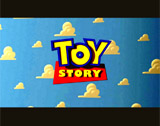
|
Toy Story (1995)
d. John Lasseter, 81 minutes, Pixar Animation Studios/Walt
Disney Pictures
- This was the first feature-length film made entirely
by computer animation, also fully digital 3-D (in a re-release
in 2009), in a collaboration between Pixar Animation Studios (its
debut film) and Disney Studios.Toy
Story (1995) became the highest-grossing (domestic) film of the
year, at $191.8 million, and made Pixar one of the premiere film studios.
- It was the first feature film of Pixar
Animation Studios to be released in theaters, created by a team
of 110 (including 27 animators) working over 800,000 hours to render
the finished movie, released in November of 1995.
- Pixar Studios had already experimented with
quite a few short subject films, most noticeably the Oscar-nominated
short Luxo Jr.
(1986) (whose characters became the basis for their logo)
and Oscar-winning short Tin Toy (1988). It was the
only Pixar film to have full opening credits, and the first Pixar
film to be adapted for television. It was also the first
Pixar film to debut (in 2008) as a live action musical on Disney
Cruise Line's The Disney Wonder.
- It was nominated for three Academy Awards: Best
Original Song (Randy Newman's You've Got a Friend in Me), Best
Original Musical Score, and Best Original Screenplay (without any
wins). It was the first animated movie nominated for Best
Original Screenplay. John Lasseter was awarded
a Special Achievement Academy Award for the groundbreaking movie.
- The cutting-edge animation was the first totally-digital
(or computer-generated) feature-length animated film - a trend that
would continue to entertain audiences for decades. The visuals
were entirely generated from computers, creating a wonderfully-realistic
3-D world with lighting, shading, and textures, that included real
toys in supporting roles (Etch-A-Sketch, Slinky Dog, the plastic
toy soldiers, Mr. Potato Head, etc.).
- The film's amazing computer effects were surpassed
only by the intelligent, thoughtful script that had adult themes
that both parents and their kids could relate to. It placed major
emphasis on its characters and their voices - it was essentially
a buddy film between anthropomorphic cowboy doll Woody (voice of
Tom Hanks) and space ranger action figure Buzz Lightyear
(voice of Tim Allen).
- Massive commercial success came from the merchandising
of toys, video games, theme park attractions, spin-offs, numerous
products from corporate tie-ins (i.e., Burger King, Pepsi, Coca-Cola,
and Payless Shoes), and VHS rentals and sales.
- It led to a trilogy of animations: Toy
Story 2 (1999) was
the first Pixar sequel, and considered superior to the original.
It was the highest-grossing animated film of 1999. Toy Story 3
(2010) was the third installment in the popular Toy
Story series.
It was the highest-grossing (worldwide) animated film of all-time,
grossing over $1 billion. It was also the first Pixar film to be
released in 3D for its first run, and the first film to be released
theatrically with Dolby Surround 7.1 sound. It became the highest-grossing
3D animation of all-time, and the highest-grossing film of 2010.
From its five Academy Award nominations, it won twice - Best Animated
Feature Film and Best Original Song (Randy Newman's We Belong
Together).
It was the most expensive Pixar movie to ever be produced, at an
estimated budget of $200 million.
|

|
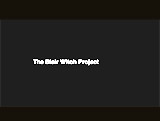
|
The Blair Witch Project (1999)
d. Daniel Myrick and Eduardo Sánchez, 81 minutes,
Haxan Films
- The pseudo-documentary, low-budget (budgeted at
about $60,000), media-savvy cult horror film grossed $140.5 million
(domestic) and $249 million (worldwide), easily making it (percentage-wise)
the most profitable film in Hollywood history (with a record budget/box
office ratio). It was the first independent
blockbuster.
- Foretelling new methods of Internet-based marketing,
Eduardo Sanchez and Daniel Myrick's roughly-made, offbeat independent
film (from small-time distributor Artisan Films) was a quasi-documentary
about an October 1994 horrifying camping trip and investigation
of a local legend that was experienced by no-name actors: three
vanished Montgomery College student film-makers (Heather, Josh,
and Mike) in Maryland's Black Hill Forest (near Burkittsville).
- The almost entirely-improvised cult film reaped
a greater audience (and successful box-office receipts) from low-cost
Internet exposure and astute promotion, advertising and marketing.
The 'Blair Witch' website, a popular destination for web surfers
(with millions of hits), created tremendous advance buzz (suggesting
that the story was real) for this low-budget film that was directed
by a group of students from the University of Central Florida in
8 days. Many believed that the story was true, rather than the
ingenious marketing hoax that it was.
- The surprise hit and media sensation,
a precursor of reality TV, was innovatively shot on 16mm B/W and
Hi-8 color digital video camcorders, and basically looked like
a home-made film with unknown actors and poor production values.
Remarkably, it had no stars, no large marketing budget, no state-of-the-art
special effects, and no creatures/monsters. Released
at the dawn of the ubiquitous camcorder revolution,
The Blair Witch Project demonstrated how a no-budget horror
film could easily be made by anyone with a camera and a means to
edit the film.
- It was the biggest 'found
footage' movie to date and it effectively kickstarted the sub-genre.
Over a decade later, 'found-footage' films had become extremely
popular, possibly due to the influence of home-made YouTube videos
and reality TV. It was extremely influential for the next generation
of similar films, including director Oren Peli's Paranormal
Activity (2007) and its sequels (from 2010-2012), the sci-fi
monster anthology Cloverfield trilogy, a franchise consisting
of Cloverfield (2008), 10 Cloverfield Lane (2016), and The
Cloverfield Paradox (2018), and the [REC] horror film
franchise from 2007-2014 - and many more.
|

|
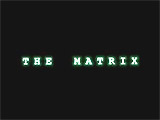
|
The Matrix (1999)
d. Andy Wachowski and Lana Wachowski, 136 minutes, Warner
Bros./Village Roadshow Pictures
- This kinetic, action-oriented, science-fiction virtual
reality film combined many innovative visual and special effects
elements comprising about 20 percent of the entire film. This groundbreaking
action film became a smash hit, featuring elaborate fighting and
stunt sequences with complex editing. Its convoluted screenplay that
blurred the edge between reality and fantasy, still did not
lose the audience's grasp of the story.
- It came from the directorial
writing team of the Wachowski brothers, and included incredible
Oscar-winning technical Visual Effects (defeating Star Wars:
Episode I - The Phantom Menace (1999) and Stuart Little
(1999)). The film was nominated for four technical Oscars
and won all of them including Best Editing,
Best Sound Editing, Best Sound Effects Editing, and Best Visual
Effects.
- The Matrix became best known for its phenomenal
and revolutionary visual effects - airborne kung fu, 3-D freeze
frame effects with a 360 degree rotating or pivoting camera, and
bullet-dodging (slowed-down, rotating action dubbed "bullet-time" and "Flow-Mo"). These
digital effects were created with suspending
actors on wires (traditional wire-work), using motion capture,
and filming segments with multiple still cameras shooting from
multiple angles, and then enhancing the pictures with CG interpolation. Some
of it was filmed against a greenscreen with a rig of cameras shooting
at 12,000 frames per second.
- Features included time-freezing, camera tracking
around frozen action, shoot-outs, wall-scaling, virtual backgrounds,
biomechanical monsters with tentacles known as Sentinels, and airborne
kung fu between computer hacker Thomas Anderson/Neo (Keanu Reeves)
and Agent Smith (Hugo Weaving).
- This popular, imaginative, visually-stunning film
made timely references to prototypical elements of the 21st century
high-tech culture, such as hacking and virtual reality, and included
bullet-dodging.
- Its tremendous visual
effects and Western-styled action cinema were combined with Eastern
world-denying philosophy, metaphysical Zen statements, Japanese
anime, Greek mythology, cyberpunk chic, neo-Cartesian plot twists,
film noir, Biblical and Lewis Carroll (Alice in Wonderland) references. Its
cyberpunk and manga traditions helped to create a live-action
anime.
- After the first film's success, a second back-to-back
film was announced - part of the trend of creating sequels (and
a potential trilogy) to capitalize on the original film's popularity.
The Matrix was the first in a trilogy with inferior sequels: the
somewhat successful but critically derided The Matrix Reloaded
(2003) and the artificially-expanded The Matrix Revolutions
(2003).
|
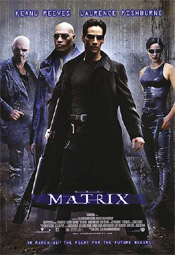
|
